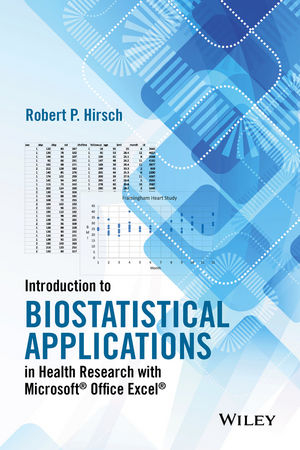
Introduction to Biostatistical Applications in Health Research with Microsoft Office Excel
John Wiley & Sons Inc (Verlag)
978-1-119-08965-0 (ISBN)
Focusing on a basic understanding of the methods and analyses in health research, Introduction to Biostatistical Applications in Health Research with Microsoft® Office Excel® provides statistical concepts for interpreting results using Excel. The book emphasizes the application of methods and presents the most common methodological procedures in health research, which includes multiple regression, ANOVA, ANCOVA, logistic regression, Cox regression, stratified analysis, life table analysis, and nonparametric parallels.
The book is constructed around a flowchart that outlines the appropriate circumstances for selecting a method to analyze a specific set of data. Beginning with an introduction to the foundational methods of statistical logic before moving on to more complex methods, Introduction to Biostatistical Applications in Health Research with Microsoft® Office Excel® also includes:
Detailed discussions of how knowledge and skills in health research have been integrated with biostatistical methods
Numerous examples with clear explanations that use mostly real-world health research data in order to provide a better understanding of the practical applications
Implements Excel graphic representations throughout to help readers evaluate and analyze individual results
An appendix with basic information on how to use Excel
A companion website with additional Excel files, data sets, and homework problems as well as an Instructor’s Solutions Manual
Introduction to Biostatistical Applications in Health Research with Microsoft® Office Excel® is an excellent textbook for upper-undergraduate and graduate-level courses in biostatistics and public health. In addition, the book is an appropriate reference for both health researchers and professionals.
Robert P. Hirsch, PhD, is on the faculty for the Foundation for the Advanced Education in the Sciences within the Graduate School at the National Institutes of Health. He is also a retired Professor of Epidemiology and Biostatistics and Adjunct Professor of Statistics at The George Washington University. Dr. Hirsch is the author of numerous books in the field of health research and practice.
Preface ix
Acknowledgements xi
Notices xiii
About The Companion Website xv
Part One Basic Concepts 1
1 Thinking about Chance 3
1.1 Properties of Probability 3
1.2 Combinations of Events 7
1.2.1 Intersections 8
1.2.2 Unions 13
1.3 Bayes’ Theorem 15
2 Describing Distributions 18
2.1 Types of Data 19
2.2 Describing Distributions Graphically 19
2.2.1 Graphing Discrete Data 20
2.2.2 Graphing Continuous Data 22
2.3 Describing Distributions Mathematically 26
2.3.1 Parameter of Location 27
2.3.2 Parameter of Dispersion 31
2.4 Taking Chance into Account 38
2.4.1 Standard Normal Distribution 39
3 Examining Samples 49
3.1 Nature of Samples 50
3.2 Estimation 51
3.2.1 Point Estimates 51
3.2.2 The Sampling Distribution 56
3.2.3 Interval Estimates 60
3.3 Hypothesis Testing 64
3.3.1 Relationship between Interval Estimation and Hypothesis Testing 72
Part Two Univariable Analyses 75
4 Univariable Analysis of a Continuous Dependent Variable 79
4.1 Student’s t-Distribution 81
4.2 Interval Estimation 84
4.3 Hypothesis Testing 86
5 Univariable Analysis of an Ordinal Dependent Variable 90
5.1 Nonparametric Methods 90
5.2 Estimation 94
5.3 Wilcoxon Signed-Rank Test 95
5.4 Statistical Power of Nonparametric Tests 97
6 Univariable Analysis of a Nominal Dependent Variable 99
6.1 Distribution of Nominal Data 100
6.2 Point Estimates 101
6.2.1 Proportions 101
6.2.2 Rates 104
6.3 Sampling Distributions 108
6.3.1 Binomial Distribution 108
6.3.2 Poisson Distribution 112
6.4 Interval Estimation 114
6.5 Hypothesis Testing 117
Part Three Bivariable Analyses 121
7 Bivariable Analysis of a Continuous Dependent Variable 123
7.1 Continuous Independent Variable 123
7.1.1 Regression Analysis 125
7.1.2 Correlation Analysis 149
7.2 Ordinal Independent Variable 165
7.3 Nominal Independent Variable 166
7.3.1 Estimating the Difference between the Groups 166
7.3.2 Taking Chance into Account 167
8 Bivariable Analysis of an Ordinal Dependent Variable 175
8.1 Ordinal Independent Variable 176
8.2 Nominal Independent Variable 184
9 Bivariable Analysis of a Nominal Dependent Variable 189
9.1 Continuous Independent Variable 190
9.1.1 Estimation 191
9.1.2 Hypothesis Testing 198
9.2 Nominal Independent Variable 200
9.2.1 Dependent Variable Not Affected by Time: Unpaired Design 201
9.2.2 Hypothesis Testing 208
9.2.3 Dependent Variable Not Affected by Time: Paired Design 218
9.2.4 Dependent Variable Affected by Time 223
Part Four Multivariable Analyses 227
10 Multivariable Analysis of a Continuous Dependent Variable 229
10.1 Continuous Independent Variables 230
10.1.1 Multiple Regression Analysis 231
10.1.2 Multiple Correlation Analysis 247
10.2 Nominal Independent Variables 248
10.2.1 Analysis of Variance 249
10.2.2 Posterior Testing 258
10.3 Both Continuous and Nominal Independent Variables 265
10.3.1 Indicator (Dummy) Variables 266
10.3.2 Interaction Variables 267
10.3.3 General Linear Model 273
11 Multivariable Analysis of an Ordinal Dependent Variable 281
11.1 Nonparametric Analysis of Variance 282
11.2 Posterior Testing 288
12 Multivariable Analysis of a Nominal Dependent Variable 293
12.1 Continuous And/or Nominal Independent Variables 294
12.1.1 Maximum Likelihood Estimation 294
12.1.2 Logistic Regression Analysis 297
12.1.3 Cox Regression Analysis 306
12.2 Nominal Independent Variables 307
12.2.1 Stratified Analysis 308
12.2.2 Relationship between Stratified Analysis and Logistic Regression 318
12.2.3 Life Table Analysis 322
Appendix A: Flowcharts 335
Appendix B: Statistical Tables 341
Appendix C: Standard Distributions 377
Appendix D: Excel Primer 380
Index 385
| Erscheint lt. Verlag | 15.4.2016 |
|---|---|
| Verlagsort | New York |
| Sprache | englisch |
| Maße | 158 x 239 mm |
| Gewicht | 748 g |
| Themenwelt | Mathematik / Informatik ► Mathematik ► Wahrscheinlichkeit / Kombinatorik |
| Medizin / Pharmazie ► Medizinische Fachgebiete | |
| Studium ► Querschnittsbereiche ► Prävention / Gesundheitsförderung | |
| ISBN-10 | 1-119-08965-4 / 1119089654 |
| ISBN-13 | 978-1-119-08965-0 / 9781119089650 |
| Zustand | Neuware |
| Haben Sie eine Frage zum Produkt? |
aus dem Bereich


